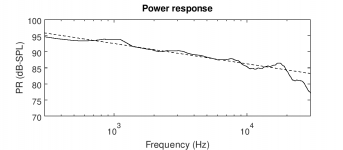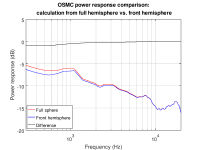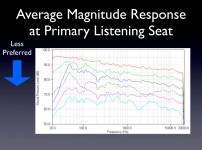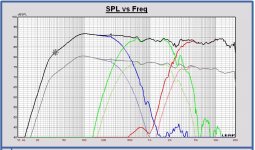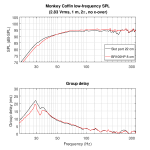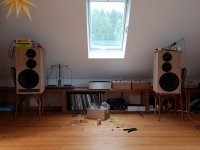Here is the power response determined from the same data as shown in post 895. The slope of the dashed line is -1.9 dB/octave.
I used this code to calculate power response. It is based on the method described by Joe Tylka.
I used this code to calculate power response. It is based on the method described by Joe Tylka.
Attachments
Here is the power response determined from the same data as shown in post 895. The slope of the dashed line is -1.9 dB/octave.
I don't completely understand the combination of a sound that is ok and a power and SPL response with a slight fall off in the medium frequency range (referring to post #813 also).
My experience with speaker design is that SPL and power have to be almost flat between about 300 and 3000 Hz for a good room sound (conform my personal taste).
IMO a system with these drivers would perform also well without the waveguide and a SPL and power response being more flat. ATC speakers with the dome midrange don't use the waveguide neither.
But ok the design choice with the waveguide has been made after a good investigation for the best horizontal dispersion. I am not convinced if it is the best choice for the best sound in a room for this speaker system...
Last edited:
Look at the impedance vs. phase... Absolutely beautiful!!! 
I haven’t built box speakers in the better part of 20 years. Looks like I’ll have a project to do once the queue clears up. 🙂 🙂 🙂

I haven’t built box speakers in the better part of 20 years. Looks like I’ll have a project to do once the queue clears up. 🙂 🙂 🙂
"IEC 60268-5 provides the international standard definitions and requirements for loudspeakers and states that the nominal impedance of a loudspeaker is determined such that the minimum impedance is never less than 80% of the nominal impedance."
https://www.isce.org.uk/wp-content/uploads/EngineeringNote-11.3-loudspeakers-impedance-and-power.pdf
"The (IEC) standard goes on to say that the minimum impedance within the rated frequency range shall not be less than 0.8 of the rated impedance, and if it is lower than that outside the rated frequency range, including d.c., the manufacturer should say so. Since it usually is lower at d.c., the d.c. resistance should be specified, but it often isn't. To determine the rated impedance, the manufacturer should measure the minimum impedance of a number of samples, find the average and set the rated impedance at 1.25 (= 1/0.8) times that average value. The value can't be predicted very accurately (without a sophisticated simulation program) because the electrical impedance depends to some extent on the mechanical and acoustic characteristics of the drive unit, or of all the drive units and crossover networks in a multi-driver loudspeaker system."
https://www.isce.org.uk/wp-content/uploads/EngineeringNote-11.3-loudspeakers-impedance-and-power.pdf
"The (IEC) standard goes on to say that the minimum impedance within the rated frequency range shall not be less than 0.8 of the rated impedance, and if it is lower than that outside the rated frequency range, including d.c., the manufacturer should say so. Since it usually is lower at d.c., the d.c. resistance should be specified, but it often isn't. To determine the rated impedance, the manufacturer should measure the minimum impedance of a number of samples, find the average and set the rated impedance at 1.25 (= 1/0.8) times that average value. The value can't be predicted very accurately (without a sophisticated simulation program) because the electrical impedance depends to some extent on the mechanical and acoustic characteristics of the drive unit, or of all the drive units and crossover networks in a multi-driver loudspeaker system."
... the design choice with the waveguide has been made after a good investigation for the best horizontal dispersion. I am not convinced if it is the best choice for the best sound in a room for this speaker system...
Why do you think that tweeter on the flat baffle would be superior to waveguide loaded tweeter ?
I don't completely understand the combination of a sound that is ok and a power and SPL response with a slight fall off in the medium frequency range (referring to post #813 also).
Well, I guess that's a question about how we perceive the sound balance of a loudspeaker. We hear a combination of the direct sound coming from the drivers (corresponding to the anechoic SPL) and the reverberating sound from the room. With a directional speaker, the proportion of the direct sound at the listener position is larger than with an omnidirectional speaker.
The sloping power response is just the consequence of the directivity increase towards higher frequencies (as seen in the polar plots of post 895). I don't think the slope of the power response is very conclusive for assessing the sound balance perceived by the listener. What is more important to me is that the power response curve has no pronounced peaks or dips.
The waveguide idea with the Monkey Coffin was to (i) match the directivities of the midrange and tweeter, (ii) to reduce the room effects at the listener position, (iii) to reduce the effects of baffle diffraction, and (iv) to reduce non-linear distortion from the tweeter (because lower drive voltage can be used for a given SPL output).
Note that I am not saying that a design without a waveguide would not be good. Just different.
Last edited:
Why do you think that tweeter on the flat baffle would be superior to waveguide loaded tweeter ?
The power response transition between a 3 inch midrange and a 1 inch dome tweeter can be made smooth without using the waveguide (crossing around 2 - 2.5 kHz).
If a larger midrange is used, 7 or 8 inch, then a tweeter waveguide is recommended, because it will reduce the power of the tweeter for the same SPL on axis and the power transition between midrange and tweeter is improved...
If it is possible I prefer a less directional concept, because there will be more high frequency power in the room for the same SPL curve on axis. I think it will give more life performance in a mean listening room.
The sloping power response is just the consequence of the directivity increase towards higher frequencies (as seen in the polar plots of post 895). I don't think the slope of the power response is very conclusive for assessing the sound balance perceived by the listener. What is more important to me is that the power response curve has no pronounced peaks or dips.
I have some doubts because, besides the power response, the SPL on axis is also slightly falling off to high frequencies.
If I have understood it well the xo filter is tuned on a mono set in a less damped listening environment.
I think some xo tweaking still can be interesting with the stereo set in a more damped room. Just my perception till now...
If I have understood it well the xo filter is tuned on a mono set in a less damped listening environment.
I think some xo tweaking still can be interesting with the stereo set in a more damped room. Just my perception till now...
This is correct. I have also briefly listened to the Monkey Coffins it our living room (I liked the sound), but they couldn't stay for long enough because of issues related to WAF and the cat. I will certainly do some more listening in real living-room environments later on.
I will also try to get some listening feedback from other people. However, describing the sound qualities of a loudspeaker is very difficult, and understanding such descriptions is even more difficult. Just take a loudspeaker review from the typical HiFi magazine and try to really understand what they are saying about the sound of the speaker. Good luck... 😉
I thought of setting up a Vituix project containing the full data of the x-over and the drivers (acoustic, impedance). So far, Vituix gave surprisingly good "forecasts" of the observed results. People could then just build the Monkey Coffin -- and if they think it sounds too "bright" or too "dull" or whatever, they can tweak it using Vituix as a reliable guide.
Yes, good idea. I will use Vituix also in the future, it is interesting to have the same tool in a project.I thought of setting up a Vituix project containing the full data of the x-over and the drivers (acoustic, impedance). So far, Vituix gave surprisingly good "forecasts" of the observed results. People could then just build the Monkey Coffin -- and if they think it sounds too "bright" or too "dull" or whatever, they can tweak it using Vituix as a reliable guide.
To measure the total power exactly, you need to measure the SPL curves in the complete horizontal and vertical orbits around the cabinet. Like Floyd Toole describes in its analysis, very complicate to do it ourselves.
I also tried to better understand how much "off" the Vituix estimation of the power response is due to currently missing measurement data at 90°...180° (i.e., the SPL behind the speaker). To this end, I estimated the horizontal dispersion at different angles beyond the 90° off axis level using the diffraction calculator. From my eyeballing, I'd estimate the mean SPL at 90°...180° to be about 15 dB lower than from 0°...90° (at 1 kHz). Since the diffraction calculator neglects the beaming of the waveguides, this difference can be expected to be quite a bit more due to the waveguides.
If in reality the mean SPL were 20 dB lower in the 90°...180° half space than in the 0°...90° range, the summed total from 0°...180° would be higher by about 0.8 dB than the sum from 0°...90°. While this is just a rough estimate, it shows that the effect of neglecting the 90°...180° data is not huge. In fact, it might be quite a bit less than the difference of the true, full 3D result one would get from spherically distributed measurements (or an accurate model, although that might not exist).
Mbrennwa, is it time to change "no need to it" to proper measurements? 🙂
Alright, just of curiosity I thought I'd look at this again using the new SPL measurements covering the full sphere around the speaker (on horizontal and vertical orbits). I compared the power response calculated using the full-sphere data vs. using the front-hemisphere data only. The result is shown in the attachment. Not surprisingly, the difference is largest at low frequencies (about 1 dB), where the speaker is more omindirectional. The difference is 1 dB at 300 Hz, 0.5 dB at 1 kHz, and vanishingly low at higher frequencies. This is consistent with my above guesstimate.
Attachments
Here's a quick update from the listening evaluation. Listening is done in home environment, using my "Mac Gyver" KT66 tube amp (max. 11 W into 8 Ohm) and a FirstWatt F5 amp (25 W into 8 Ohm). x-over filters are EL2019030 version.
Describing sound is not easy, but here it goes...
The good things:
Not so good (and how to fix things):
Describing sound is not easy, but here it goes...
The good things:
- Both amps have no problem to go drive the speakers. They can go loud enough to wake up the kids sleeping two floors below, all doors closed.
- Timbre is nicely balanced (with exceptions noted below), although the SPL curve(s) show a slight decrease towards higher frequencies.
- Sound is very transparent and dynamic. Integration between the drivers is very good (you don't hear the woofer, midrange, or tweeter -- just a speaker).
- Imaging is good. Close your eyes for a while, and then open again. With most speakers, the sound seems to go from the 3D stage to the speakers when you open the eyes. This does not happen with the Monkey Coffin.
Not so good (and how to fix things):
- After longer listening sessions, something did not seem right in the lower treble. After listening to the individual drivers it was obvious the issue is related to the tweeter. Looking at the filter transfer functions it loos like the transition from the stop band to the pass band has a bit of a "sharp kink", which might affect group delay. A simple change in the parallel inductor of the tweeter filter from 0.22 mH to 0.18 mH solved this issue.
- Bass is clean and deep, but too lean. I took another look at the bass tuning using the microphone-in-box technique. This allowed me to determine the low-frequency SPL without the issues involved in summing the woofer and port SPL (crosstalk, phase inconsistencies). It seems we overdid the bass-reflex tuning a bit when we decided to tune it low in order to get a smooth roll off. The roll off started above 100 Hz, and was way lower than intended (-3 dB @ 50 Hz). I shortened the BR ports until I got closer to the intended low-frequency curve, and I am now listening to this. I still need to adapt the impedance compensation for the upper BR impedance peak.
It stays strange with this design that the SPL has to be decreasing to high frequencies for a good sound. It is about 3 dB, not so slight in my opinion.
If I look back to my own designs, if I designed the SPL response like that, it did sound dark, less expressive without any life experience, not amusing. I have to remark that all my designs have been done without waveguide. But with waveguide the room power is even lower for the same SPL on axis. So I shouldn’t expect that the high frequency power has to be set lower with the waveguide.
Maybe try out a more flat response also, now it is a stereo set and placed in a living room with the intended amplifiers. Just to know maybe. Now the xo design was finalized on a mono set in a more reflecting room.
W.r.t. the bass, maybe you have to try a more B4 response, in a way the woofer response is more flat in its passband. Now the response has a little boost above 100 Hz. I think you realized it already making the port shorter. But I am surprised also that the bass sounds too lean, looking to the SPL decreasing response. Difficult to understand this. In my own elliptical designs I could improve this aspect by tweaking the woofer response around the xo point. Making the transition more sharp (higher Q) was better. The bass did get more “punch” in that way, for the elliptical filter.
If I look back to my own designs, if I designed the SPL response like that, it did sound dark, less expressive without any life experience, not amusing. I have to remark that all my designs have been done without waveguide. But with waveguide the room power is even lower for the same SPL on axis. So I shouldn’t expect that the high frequency power has to be set lower with the waveguide.
Maybe try out a more flat response also, now it is a stereo set and placed in a living room with the intended amplifiers. Just to know maybe. Now the xo design was finalized on a mono set in a more reflecting room.
W.r.t. the bass, maybe you have to try a more B4 response, in a way the woofer response is more flat in its passband. Now the response has a little boost above 100 Hz. I think you realized it already making the port shorter. But I am surprised also that the bass sounds too lean, looking to the SPL decreasing response. Difficult to understand this. In my own elliptical designs I could improve this aspect by tweaking the woofer response around the xo point. Making the transition more sharp (higher Q) was better. The bass did get more “punch” in that way, for the elliptical filter.
There has been quite a bit of research about what kind of SPL response curve is "right". I couldn't find the original publications / reports by Floyd Toole and Sean Olive (they seem to be hidden in non-open access papers), but there is a presentation summarising their findings. One of the slides (attached) shows the in-room SPL frequency-response curves of different loudspeakers, and how listeners rated them. The listeners liked a smooth response with a decreasing trend towards higher frequencies.
If the power response curve is used as an estimate of the in-room SPL curve, the preferred power response curve should look like the "good ones" in the attached plot. With a constant directivity loudspeaker, the on-axis response curve would have the same shape as the power response curve. While the Monkey Coffin is not a perfect constant directivity system, it is much more "constant directivity" than an average loudspeaker without waveguides. This is why the Monkey Coffin on-axis SPL response curve needs a decreasing trend towards higher frequencies for balanced sound.
I have tried a flat on-axis response curve, and it sounded very bright and very wrong to my ears.
If the power response curve is used as an estimate of the in-room SPL curve, the preferred power response curve should look like the "good ones" in the attached plot. With a constant directivity loudspeaker, the on-axis response curve would have the same shape as the power response curve. While the Monkey Coffin is not a perfect constant directivity system, it is much more "constant directivity" than an average loudspeaker without waveguides. This is why the Monkey Coffin on-axis SPL response curve needs a decreasing trend towards higher frequencies for balanced sound.
I have tried a flat on-axis response curve, and it sounded very bright and very wrong to my ears.
Attachments
IMO the preference for a more decreasing SPL with this speaker can be the use of the 3 inch midrange, which has more power than a moderate 7 to 8 inch midrange above 1- 2 kHz. To realize the same room power curve for both systems, the 3 inch needs a more decreasing SPL on axis.
But ok, it is difficult to discuss about without hearing the result, which is very good referring to Matthias' comments.
But ok, it is difficult to discuss about without hearing the result, which is very good referring to Matthias' comments.
I have added the SPL and power in one plot for the Monkey Box, results based on Matthias' results (power scaled 10 dB down) .
Power and SPL are almost parallel which shows the constant directivity.
I just wondered if the results wouldn't be better keeping the SPL at 90 dB above 500 Hz...
Power and SPL are almost parallel which shows the constant directivity.
I just wondered if the results wouldn't be better keeping the SPL at 90 dB above 500 Hz...
Attachments
I just wondered if the results wouldn't be better keeping the SPL at 90 dB above 500 Hz...
If we wanted to stick to the design targets in a strict way, we'd have to do this in order to attempt to squeeze out the max. efficiency from the design. It would not be difficult to implement by modifying the x-over. For a start, change the first inductor of the woofer from 6.8 mH to 5.6 mH, and then adjust the series resistors in the midrange and tweeter filters. This will get you there. However, this would result in incomplete baffle-step compensation and an almost flat power response. I don't think I will implement this in my build. It just does not sound right, and even my flea-power tube amp has no problems to drive the Monkey Coffin to very loud levels with the current x-over.
I also took some better measurements showing the bass alignment. The attached plot shows the free-field SPL curves (2pi)* with the 8cm long BR100HP port ("new" alignment) vs the 22cm slot port ("old" alignment). The difference is not huge, but there is about 1 dB more SPL with the new alignment from 50 Hz to about 240 Hz. This makes a surprisingly large difference to the perceived "weight" of the bass. Group delay is even slightly lower with the "new" alignment.
[*curves were measured using the mic-in-box technique for data up to 110 Hz, which was spliced to near-field measurements covering the range up to 300 Hz.]
The next task is to drag the loudspeakers from the workshop in the basement back to the listening room in the 2nd floor... these things are heavier than you'd think!
Attachments
- Home
- Loudspeakers
- Multi-Way
- Open Source Monkey Box
